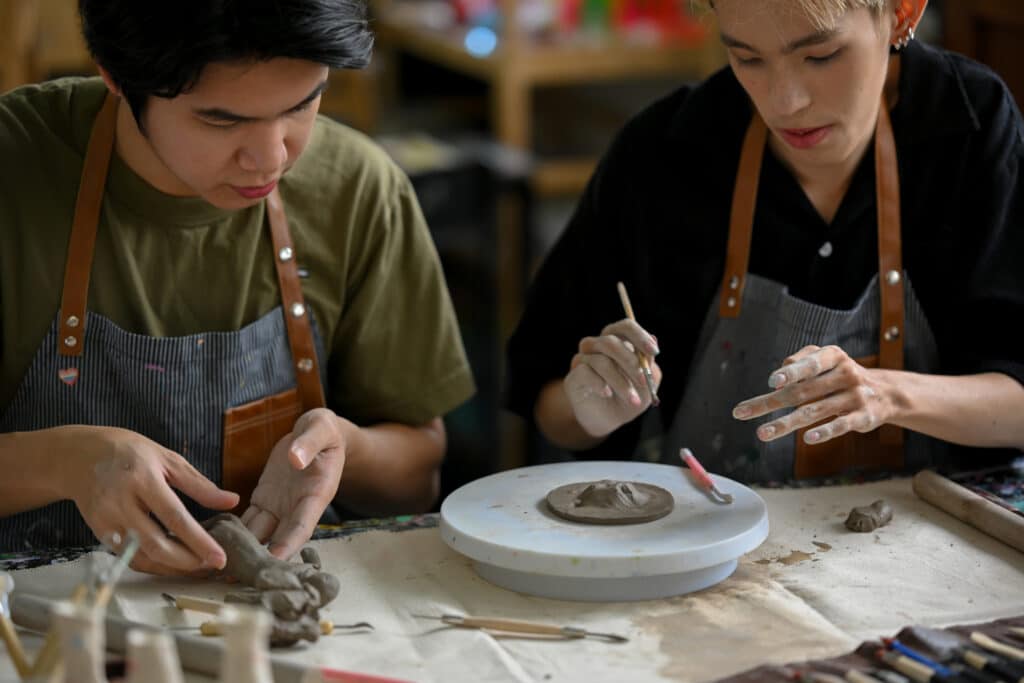Integrating Experiential Therapy into Addiction Recovery Programs
How can integrating experiential therapy techniques into addiction recovery programs sustain well-being and sobriety? Find out here.
Our Approach to Your Recovery
In today’s world, addiction and mental health challenges often demand multifaceted solutions. Vista Taos Renewal Center recognizes this and goes beyond traditional approaches by embracing holistic healing. Our philosophy acknowledges that true well-being encompasses the mind, body, and spirit.
We believe lasting recovery requires addressing all aspects of a person’s experience. Our personalized treatment plans incorporate various evidence-based methods, from psychotherapy and medication management to yoga and mindfulness practices.
This comprehensive approach fosters a foundation for long-term health and a fulfilling life.

Integrating Experiential Therapy
Traditional talk therapy plays a key role in addiction and mental health treatment. However, Vista Taos Renewal Center recognizes the power of going beyond words. By integrating experiential therapy into our programs, we effectively enhance traditional treatment modalities.
This form of therapy incorporates active and engaging experiences. Through activities like art therapy and adventure therapy, clients can explore their emotions and gain a deeper understanding of themselves.
This can help them:
- Process past experiences
- Cultivate self-awareness
- Build the skills necessary for long-term recovery
Purpose of Integrating Experiential Therapy
Experiential therapy helps people identify and address hidden or subconscious issues through different activities that engage them physically, emotionally, and mentally.
Unlike traditional talk therapy, which primarily involves verbal communication, experiential therapy involves actions, movements, and activities that help people tap into and explore their deepest emotions and thoughts.
Principles of Experiential Therapy
Experiential therapy is based on the following principles:
- Active participation: Patients actively engage in therapeutic activities. This makes therapy a dynamic experience.
- “Here and now” focus: This approach emphasizes being present and mindful. It focuses on current emotions and behaviors as gateways to understanding past patterns.
- Emotional expression: It facilitates a safe space for people to express complex emotions.
- Relationship building: Often conducted in groups, it helps build social skills, empathy, and community among participants.
- Holistic approach: It engages the whole person—body, mind, and spirit. In this way, it supports comprehensive healing and well-being.
How Integrating Experiential Activities Promotes Healing
Experiential therapy allows clients to access and articulate feelings that are often buried or unexpressed in everyday life. By taking part in dynamic activities, people experience their emotions in real time within a secure and supportive therapeutic environment.
This immediacy fosters a powerful sense of presence and opens up avenues for discussion. Engaging directly with personal issues helps understand underlying emotional patterns. This provides critical insights essential for personal growth and recovery.
Integrating Experiential Therapy at Vista Taos
At Vista Taos Renewal Center, experiential therapy forms the cornerstone of our integrative, whole-person approach. It is skillfully integrated into the broader therapeutic framework. This enhances traditional therapeutic modalities by adding a dynamic physical engagement layer.
Traditional therapies like cognitive-behavioral therapy (CBT) and psychodynamic therapy provide the framework for understanding mental health issues. In contrast, experiential therapy brings these issues into the physical realm through active participation.
This dual approach ensures that clients understand their emotional triggers and behavior patterns. Through guided therapeutic experiences, they learn to navigate and transform these triggers in real time. This synergy supports a more profound and lasting healing process.
Art Therapy
Art therapy uses creative techniques to help people express themselves artistically. These techniques include activities such as:
- Drawing
- Painting
- Collage
- Coloring
- Sculpting
It also allows them to express their psychological and emotional undertones in art. This helps address various aspects of addiction and mental health issues, including:
Reducing Anxiety, Depression, and Stress
Studies have shown that engaging in art therapy can reduce symptoms of anxiety, depression, and stress.1
This reduction is attributed to how art therapy facilitates the expression of feelings that may be difficult to articulate verbally. By externalizing these emotions, clients can confront and manage their feelings more effectively.
Decreasing Self-Harm Tendencies
Art therapy has been instrumental in decreasing tendencies toward self-harm. With a reported reduction of 54%, this therapy helps people develop healthier coping mechanisms.2
The therapy provides a symbolic way to express pain and deep-seated emotions. This reduces the need to engage in self-harm as a form of expression or relief.
Enhancing Personal Insight
As clients create and reflect on their art, they often begin to see underlying patterns of thoughts that contribute to their condition. This reflective process enables clients to express their authentic selves and helps them gain profound personal insights.
Facilitating Emotional Release and Healing
Making art in a therapeutic setting provides a safe space for emotional release. For people with addiction or mental health disorders, these moments of release are vital. They offer a way to let go of bottled-up emotions and begin the process of healing.
Outdoor Adventure Therapy
Outdoor adventure therapy involves activities that challenge clients physically and mentally. This may involve pursuits such as:
- Walking trails
- Rock climbing
- Wilderness expeditions
This therapy leverages the natural environment to teach coping skills. Some of the benefits of adventure therapy include:
Boosting Self-Esteem
Engaging in challenging outdoor activities can help participants build confidence and self-reliance. These enhancements in self-esteem empower clients to make positive choices and prevent relapse.
A study on outdoor adventure therapy highlighted that participants exhibited statistically significant improvements in self-esteem.3
Developing Coping Strategies and Resilience
Outdoor adventure therapy helps participants confront real-world obstacles in a controlled environment. This experience is invaluable for developing effective coping strategies and resilience. It helps manage everyday stressors associated with substance use and mental health issues.
Enhancing Social Skills and Teamwork
Outdoor adventure therapy often requires teamwork and effective communication. This fosters a sense of community and mutual support among participants.
Dance Therapy
At Vista Taos Renewal Center, dance therapy helps clients connect their physical movements with emotional expression. This facilitates healing in a dynamic and embodied way.
Some of the benefits of dance therapy include:
Widespread Impact
A comprehensive study highlights the effectiveness of dance therapy in managing a spectrum of mental health conditions.
Listed below are the percentages of people who reported improvement for various conditions:4
- 96.3% for managing depression
- 96.2% for anxiety
- 94.9% for trauma-related symptoms
- 89.4% for chronic pain
- 87.8% for substance use
Emotional and Physical Integration
Dance therapy helps people integrate emotional experiences with physical movements. This can be particularly powerful for those who have experienced trauma.
The physical expression of dance provides a non-verbal outlet for emotions. This leads to breakthroughs not possible through traditional talk therapy.
Enhancing Body Awareness
Clients develop an increased awareness of their bodies and learn to appreciate their movement capabilities. This can significantly boost body image. This newfound confidence is crucial for those dealing with chronic pain.
Fostering Social Connections
Dance therapy is often conducted in group settings. It provides participants with a sense of community and shared experience.
This social aspect of dance therapy can reduce feelings of isolation. It also encourages social interaction and builds supportive relationships.
Tailoring Experiential Therapy to Individual Needs
At Vista Taos Renewal Center, experiential therapy is highly individualized. Before initiating therapy, therapists conduct comprehensive assessments. This helps us understand each client’s condition’s specific emotional, cognitive, and physical aspects.
This detailed evaluation allows therapists to tailor activities to suit each person’s needs.
Integration of Experiential Therapy into Treatment Schedules
Experiential therapy sessions at Vista Taos Renewal Center are thoughtfully integrated into the overall treatment schedule. This complements other therapeutic modalities and enhances the treatment experience.
We schedule sessions regularly to ensure that our clients have consistent opportunities to engage in experiential learning. We align timing and frequency of these sessions with other elements of the treatment plan.
This includes paying attention to things such as:
- Psychotherapy sessions
- Medical appointments
- Group meetings
Enhancing Therapeutic Relationships
The success of experiential therapy at Vista Taos Renewal Center relies on the collaboration between therapists and clients. Therapists act as facilitators, guides, and supportive partners during these sessions. They work closely with clients to explore and reflect on their experiences during activities.
This collaboration fosters a safe environment. This helps clients feel empowered to explore their vulnerabilities and challenge their limits.
The Role of Mindfulness and Presence in Experiential Therapy Sessions
Mindfulness is a foundational element in experiential therapy. It emphasizes the importance of presence and conscious awareness during therapeutic activities.
Experiential therapy sessions help clients become aware of their thoughts, emotions, and bodily sensations. This heightened awareness is crucial as it allows clients to experience their feelings without judgment.
This makes it easier for them to engage with and process complex emotions that arise during therapy.
Encouraging Engagement in the Present Moment
In experiential therapy, clients are encouraged to immerse themselves fully in the activities.
Therapists guide them to focus on the task at hand. In this way, they notice every detail of their experience. This includes everything from the physical sensations of the activity to the emotional responses it elicits.
This practice of engaging fully in the present moment helps clients to break away from past regrets or anxieties about the future. This facilitates a powerful and therapeutic focus on the now. Such engagement is essential for achieving meaningful therapeutic outcomes.
Complementing Traditional Therapies with Experiential Approaches
At Vista Taos Renewal Center, experiential therapy is not an isolated approach. Instead, it is integrated with traditional therapeutic methods to enhance treatment efficacy.
This integration allows clients to engage in diverse therapeutic experiences. In this way, all aspects of their recovery are addressed.
Deepening the Impact of Talk Therapy
Experiential therapy enhances the effectiveness of traditional talk therapy. It does so by allowing clients to practice the issues they discuss in their sessions in a controlled setting.
For instance, a client who discusses issues of abandonment in talk therapy can explore these themes more deeply through trust-building exercises in experiential sessions. This active engagement helps to solidify the insights gained in talk therapy.
Creating a Holistic Healing Environment
The combination of experiential therapy with other holistic healing modalities creates a powerful synergy that enhances overall treatment outcomes.
At Vista Taos Renewal Center, we pair experiential therapy with practices like yoga, meditation, or nutritional counseling to support a holistic approach to health and wellness.
Yoga and meditation improve physical and mental resilience. On the other hand, experiential therapy allows clients to actively apply these new skills in challenging scenarios. It ensures that mental health improvements are intertwined with improvements in physical and emotional health.
5 Keys Tips to Ignite Your Experiential Therapy Journey
Here are five tips to getting the most out of experiential therapy:
Don't Hold Back
Experiential therapy thrives on active participation. Step outside your comfort zone and fully engage in the activities and exercises your therapist suggests. The more open you are, the richer the experience will be.
Listen to Your Body
Pay close attention to what your body is telling you during sessions. Experiential therapy can bring up emotions that manifest physically.
Notice any:
- Tightness
- Relaxation
- Discomfort
Sharing these sensations with your therapist can offer valuable insights.
Reflect After the Journey
Take time after each session to reflect on your experience. Write down your thoughts, feelings, and any realizations that surfaced during the activities. This reflection deepens your understanding and helps you connect the dots between the exercises and your personal growth.
Embrace the New
Experiential therapy involves trying new things. Approach the exercises with an open mind and a willingness to experiment. Stepping outside your usual patterns can lead to surprising breakthroughs.
Trust the Path, Even When It's Bumpy
Remember, growth can be uncomfortable. If an activity brings up challenging emotions, trust that it’s part of the process. By working through these emotions with your therapist, you can gain valuable self-awareness and develop healthier coping mechanisms.

Ready to Begin Integrating Experiential Therapy in Your Healing Journey?
Experience-based therapy is an integral part of treatment at Vista Taos Renewal Center. Participation begins with an assessment by our skilled therapists. This helps tailor activities that best suit each client’s needs.
Our experts ensure that each experiential therapy session aligns with the client’s therapeutic objectives. This helps us integrate it seamlessly with other ongoing treatments, providing a holistic approach to recovery.
Getting Started at Vista Taos Renewal Center
If you or your loved one are ready to start the recovery journey, Vista Taos Renewal Center will guide you through every step of the admissions process. Feel free to contact us if you want to explore how our programs can help.
Our admissions team is available to help with:
- Insurance verifications
- Financial arrangements
- Scheduling your initial assessment
Our goal is to make your therapy experience as smooth and supportive as possible.
Contact Vista Taos Renewal Center Today
By choosing Vista Taos Renewal Center, you can embark on a path to sustainable wellness and profound personal change, supported by our dedicated team every step of the way. Reach out to us today to get started.
Table of Contents
Ready to Renew Your Life and Well-Being?
Reach out to Vista Taos Renewal Center today and let us guide you toward sustainable recovery. We will help you heal from the addictions and substance use challenges that hinder you from leading your most fulfilled life through personalized, whole-person treatment.



